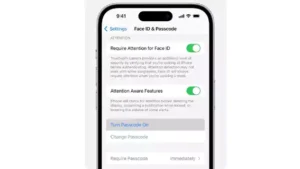Pattern Lock Unavailable on iPhones: This basic feature found in even the cheapest Android phones is not available in iPhone, what is the reason?
If you own an iPhone, you’ll never have access to a feature that’s readily available even on the most affordable Android devices. This feature is ubiquitous across all Android smartphones but notably absent on iPhones. Let’s explore which feature iPhones lack, despite being premium devices.
Pattern Lock feature Unavailable on iPhones
The iPhone remains the preferred choice for many users due to its sleek design and advanced features. It’s a coveted device that people often save up for months to purchase, making their dreams a reality. However, it may come as a surprise that iPhones lack a feature commonly found on even the most basic Android phones. So, what’s this feature? It’s none other than the security pattern lock available on Android devices.
Even the priciest iPhones don’t offer the pattern lock feature present on Android devices. iPhone users are limited to using a passcode or fingerprint for unlocking their devices. They don’t have the option to set a pattern lock. But why hasn’t Apple included this commonplace feature in its iPhones? Let’s delve into the details.
Pattern Lock Unavailable on iPhones: Apple has omitted the pattern unlock feature from iPhones. Pattern unlock is a user-friendly feature that’s easy for anyone to use and remember. It’s especially convenient for individuals who may struggle to remember numerical passcodes. However, despite its simplicity, Apple has chosen not to implement the pattern lock feature on any of its iPhones.
Reason Behind the Absence: Research into password security has revealed that pattern unlock is easier to recall than a passcode. If someone observes you unlocking your phone using a pattern, they can easily memorize it. This simplicity poses a security risk, as people may find it easier to remember a pattern than a passcode. Consequently, Apple has deemed the pattern unlock feature less secure and opted not to incorporate it into iPhones.
Setting a Passcode on iPhone: While most people are familiar with setting a passcode on their iPhones, for those who aren’t, here’s a step-by-step guide:
- For iPhone X and later models, or iPads with Face ID, navigate to Settings, then tap on Face ID and Passcode. For older iPhone models, tap on Touch ID & Passcode, then select Turn Passcode On.
- Enter a six-digit passcode. Alternatively, you can choose other passcode options such as Numeric Code, Custom Numeric Code, or Custom Alphanumeric Code.

Difficulty in Remembering Passcodes: It’s advisable to change your passcode regularly to enhance your iPhone’s security. By setting a strong passcode, you make it challenging for others to memorize and access your device, even if they observe you unlocking it.
In conclusion, while iPhones offer robust security features, the absence of the pattern unlock feature is a notable difference compared to Android devices. However, users can still ensure the security of their iPhones by setting strong passcodes and regularly updating them.